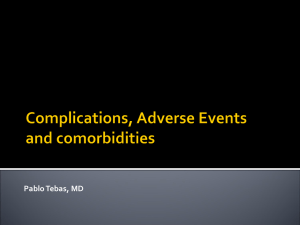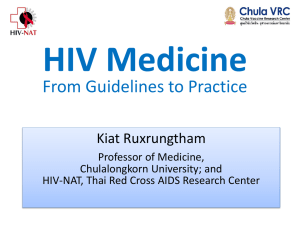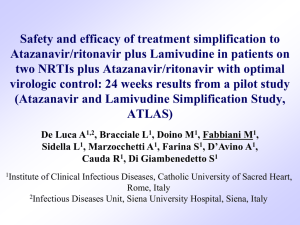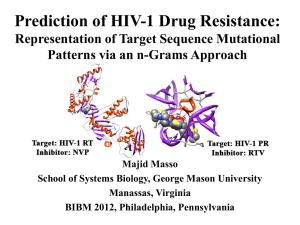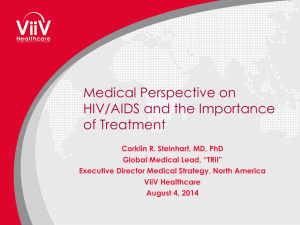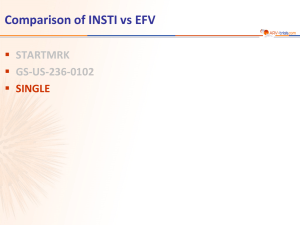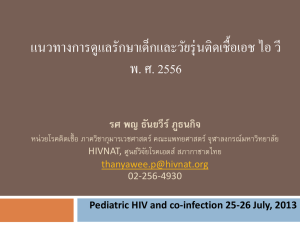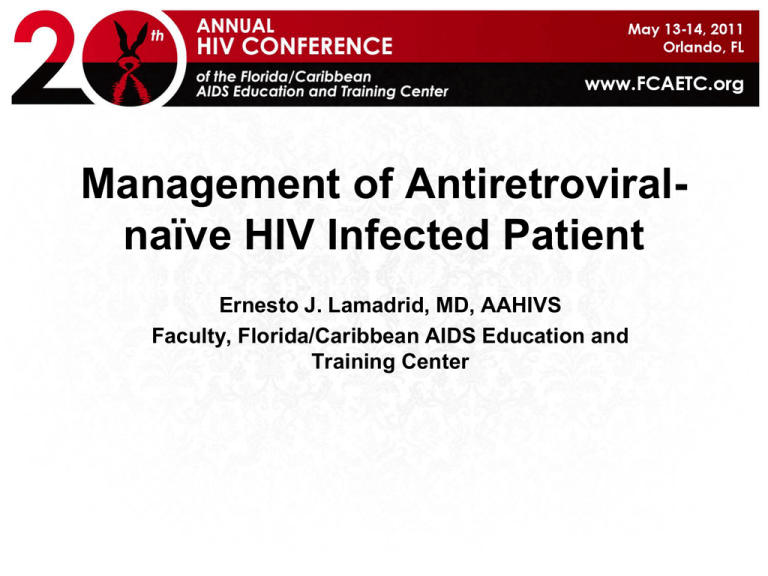
Management of Antiretroviralnaïve HIV Infected Patient
Ernesto J. Lamadrid, MD, AAHIVS
Faculty, Florida/Caribbean AIDS Education and
Training Center
Disclosure of Financial Relationships
This speaker has no significant financial relationships with
commercial entities to disclose.
This slide set has been peer-reviewed to ensure that there are
no conflicts of interest represented in the presentation.
Scope of the Problem: Burden of HIV
Infection in the United States
100
Persons (%)
80
~ 25%
unaware
of infection
Accounting for:
~ 54%
of new
infections
60
40
~ 75%
aware of
infection
20
0
People Living
With HIV/AIDS
1,039,000-1,185,000
~ 46%
of new
infections
New Sexual
Infections Each Yr
~ 32,000
Marks G, et al. AIDS. 2006;20:1447-1450.
Campsmith ML, et al. J Acquir Immune Defic Syndr. 2010;53:619-624.
Goals of Treatment
• Improve quality of life
• Reduce HIV-related morbidity and mortality
• Restore and/or preserve immunologic
function
• Maximally and durably suppress HIV viral
load
• Prevent HIV transmission
Coffey S. Guidelines for the Use of Antiretroviral Agents in Adults and Adolescents:
Initiation of Therapy [PowerPoint]. AIDS Education and Training Centers, National
Resource Center; January 2011
DHHS. Available at: http://aidsinfo.nih.gov/contentfiles/AdultandAdolescentGL.pdf.
Tools to Achieve Treatment Goals
• Selection of ARV regimen
• Maximizing adherence
• Pretreatment resistance testing
Coffey S. Guidelines for the Use of Antiretroviral Agents in Adults and Adolescents:
Initiation of Therapy [PowerPoint]. AIDS Education and Training Centers, National
Resource Center; January 2011
Factors Associated With Poor
Adherence
Psychosocial factors
(eg, depression,
homelessness, dementia)
HIV-related
stigma
Low literacy level
Current substance
abuse
Poor Adherence
Treatment fatigue
Complicated drug regimens
Adverse effects of drugs
Age-specific factors
(eg, visual or
cognitive impairment)
Difficulty taking meds
(eg, problems swallowing pills,
erratic schedule)
DHHS. Available at: http://aidsinfo.nih.gov/contentfiles/AdultandAdolescentGL.pdf.
Potential Benefits of Early Therapy
(CD4 count >500 cells/µL)
• Cohort study data show survival benefit if
ART initiated at CD4 count >500 cells/µL
• Earlier ART may prevent HIV-related end
organ damage; deferred ART may not
reliably repair damage acquired earlier
• Increasing evidence of direct HIV effects on various
end organs and indirect effects via HIV-associated
inflammation
• End organ damage occurs at all stages of infection
Coffey S. Guidelines for the Use of Antiretroviral Agents in Adults and Adolescents:
Initiation of Therapy [PowerPoint]. AIDS Education and Training Centers, National
Resource Center; January 2011
Potential Benefits of Early Therapy
(CD4 count >500 cells/µL) (2)
• Potential decrease in risk of many
complications, including:
•
•
•
•
•
•
HIV-associated nephropathy
Liver disease progression from hepatitis B or hepatitis C
Cardiovascular disease
Malignancies (AIDS defining and non-AIDS defining)
Neurocognitive decline
Blunted immunological response owing to ART initiation at older
age
• Persistent T-cell activation and inflammation
Coffey S. Guidelines for the Use of Antiretroviral Agents in Adults and Adolescents:
Initiation of Therapy [PowerPoint]. AIDS Education and Training Centers, National
Resource Center; January 2011
Potential Benefits of Early Therapy
(CD4 count >500 cells/µL) (3)
• Prevention of sexual and bloodborne
transmission of HIV
• Prevention of mother-to-child
transmission of HIV
Coffey S. Guidelines for the Use of Antiretroviral Agents in Adults and Adolescents:
Initiation of Therapy [PowerPoint]. AIDS Education and Training Centers, National
Resource Center; January 2011.
Potential Limitations of Early Therapy
(CD4 count >500 cells/µL)
•
•
•
•
ARV-related toxicities
Drug resistance
Nonadherence to ART
Cost
Coffey S. Guidelines for the Use of Antiretroviral Agents in Adults and Adolescents:
Initiation of Therapy [PowerPoint]. AIDS Education and Training Centers, National
Resource Center; January 2011
Recommendations for Initiating ART
Clinical Category or CD4 Count
History of AIDS-defining illness
CD4 count <350 cells/µL
CD4 count 350-500 cells/µL
Pregnant women
HIV-associated nephropathy (HIVAN)
Hepatitis B (HBV) coinfection, when
HBV treatment is indicated*
Recommendation
Initiate ART
* Treatment with fully suppressive drugs active against both HIV and HBV is
recommended.
Coffey S. Guidelines for the Use of Antiretroviral Agents in Adults and Adolescents:
Initiation of Therapy [PowerPoint]. AIDS Education and Training Centers, National
Resource Center; January 2011
Recommendations for Initiating ART(2)
Clinical Category or CD4
Count
CD4 count >500 cells/µL,
asymptomatic, without
conditions listed above
Recommendation
50% of the Panel favors
starting ART; 50%
views ART as optional
Coffey S. Guidelines for the Use of Antiretroviral Agents in Adults and Adolescents:
Initiation of Therapy [PowerPoint]. AIDS Education and Training Centers, National
Resource Center; January 2011
Consider More Rapid Initiation of ART
•
•
•
•
Acute opportunistic infection
Lower CD4 count (eg, <200 cells/µL)
Rapid decline in CD4
Higher viral load
Coffey S. Guidelines for the Use of Antiretroviral Agents in Adults and Adolescents:
Initiation of Therapy [PowerPoint]. AIDS Education and Training Centers, National
Resource Center; January 2011
Consider Deferral of ART
• Clinical or personal factors may support deferral
of ART
• If CD4 count is low, deferral should be considered
only in unusual situations, and with close follow-up
• When there are significant barriers to adherence
• If comorbidities complicate or prohibit ART
• “Elite controllers” and long-term nonprogressors
Coffey S. Guidelines for the Use of Antiretroviral Agents in Adults and Adolescents:
Initiation of Therapy [PowerPoint]. AIDS Education and Training Centers, National
Resource Center; January 2011
Case study #1: AG
• 38 Y/O WM goes to your office for initial visit for
newly diagnosed HIV infection three months ago
at an STD clinic.
• Transmission: MSM with multiple partners
• PMH: genital warts, dyslipidemia, bipolar
depression (controlled)
• Family Hx: father CAD, mother healthy
• Occupation: bartender
• Social Hx: smoker of 1 ppd for 15 years; no IVDU,
occasional MJ.
Physical exam AG
• Well nourished, well developed, alert, NAD
• Temp=98.5 F; P=96 R=18 BP=138/88,
Weight: 215 BMI=32
• Physical exam unremarkable except for
multiple anal Condylomas
AG Laboratory tests
•
•
•
•
•
•
•
•
CBC WNL
CMP: fasting gluc=102, GFR=75 otherwise normal
Fasting lipids: LDL=135 HDL=38 TG=152
Urinalysis: trace protein
CD4=420 (25%), 396 (22%)
HIV VL=39,852, 48,698
HIV genotype=WT
HBsAg (-) HBcAb (-), HBsAb (-) HCV Ab (-)
HAV Ab (+)
• HLA-B5701 (-)
• RPR=NR GC (-) CT (+)
Would you recommend starting ART?
1. Yes
2. No
What to Start With?
Current ARV Medications
NRTI
PI
Abacavir (ABC)
Atazanavir (ATV)
Didanosine (ddI)
Emtricitabine (FTC)
Lamivudine (3TC)
Stavudine (d4T)
Tenofovir (TDF)
Zidovudine (AZT,
ZDV)
Darunavir (DRV)
Fosamprenavir (FPV)
Indinavir (IDV)
Lopinavir (LPV)
Nelfinavir (NFV)
Ritonavir (RTV)
Saquinavir (SQV)
Tipranavir (TPV)
NNRTI
Integrase Inhibitor
(II)
Raltegravir (RAL)
Fusion Inhibitor
Enfuvirtide (ENF, T-20)
CCR5 Antagonist
Maraviroc (MVC)
Delavirdine (DLV)
Efavirenz (EFV)
Etravirine (ETR)
Nevirapine (NVP)
Coffey S. Guidelines for the Use of Antiretroviral Agents in Adults and Adolescents:
Initiation of Therapy [PowerPoint]. AIDS Education and Training Centers, National
Resource Center; January 2011
Factors in Choosing an Initial Regimen
• Regimen efficacy
• Comorbid conditions
• Tuberculosis, liver disease, depression, cardiovascular
disease, chemical dependency, pregnancy
• Presence of transmitted resistance mutations
• Adherence potential
• Pill burden, dosing frequency, food and fluid
considerations
• Potential adverse effects or drug-drug interactions
• Potential for development of drug resistance on failure
Coffey S. Guidelines for the Use of Antiretroviral Agents in Adults and Adolescents:
Initiation of Therapy [PowerPoint]. AIDS Education and Training Centers, National
Resource Center; January 2011
Additional Factors to Consider
•
•
•
•
Patient age
Patient readiness
Likelihood of treatment adherence
Potential impact of antiretrovirals on patient
quality of life
• Additional comorbidities that could impact
success of therapy including depression
• Concurrent drugs not compatible with
antiretroviral agents
• Long-term nonprogressors or elite controllers
Coffey S. Guidelines for the Use of Antiretroviral Agents in Adults and Adolescents:
Initiation of Therapy [PowerPoint]. AIDS Education and Training Centers, National
Resource Center; January 2011
Likelihood of Achieving Normal CD4+ Cell
Count on ART Depends on BL Level
Johns Hopkins HIV Clinical Cohort[1]
BL CD4+ Cell Count
> 350
201-350
< 200
Median CD4+ Cell Count
(cells/mm3)
1000
800
ATHENA National Cohort[2]
1000
800
600
600
400
400
200
BL CD4+ Cell Count
< 50
351-500
51-200
> 500
201-350
200
0
0
1
2
3
4
Yrs on HAART
5
6
0
0
48 96 144 192 240 288 336
Wks From Starting HAART
1. Moore RD, et al. Clin Infect Dis. 2007;44:441-446. Published by The University of Chicago Press.
http://www.journals.uchicago.edu/toc/cid/current.
2. Gras L, et al. J Acquir Immune Defic Syndr. 2007;45:183-192. Reproduced with permission.
Initial ART Regimens: DHHS Categories
• Preferred
• Randomized controlled trials show optimal efficacy
and durability
• Favorable tolerability and toxicity profiles
• Alternative
• Effective but have potential disadvantages
• May be the preferred regimen in individual patients
• Acceptable
• Less virologic efficacy, lack of efficacy data, or
greater toxicities
• May be acceptable but more definitive data are
Coffey S. Guidelines for the Use of Antiretroviral Agents in Adults and Adolescents:
needed
Initiation of Therapy [PowerPoint]. AIDS Education and Training Centers, National
Resource Center; January 2011
Initial Treatment: Preferred
NNRTI based
EFV/TDF/FTC1,2
PI based
ATV/r + TDF/FTC²
DRV/r (daily) + TDF/FTC²
II based
RAL + TDF/FTC²
Pregnant women LPV/r (BID) + ZDV/3TC²
Coffey S. Guidelines for the Use of Antiretroviral Agents in Adults and Adolescents:
Initiation of Therapy [PowerPoint]. AIDS Education and Training Centers, National
Resource Center; January 2011
Choose EFV-Based Therapy?
• Why?
• Long track record
• Unbeaten in clinical trials
• Convenience
• Forgiving of missed doses
• Why not?
• CNS adverse effects
• Teratogenicity in first trimester
• Risk of resistance with treatment interruption
• Lower CD4+ cell count increase than with other drug classes
• Lipids?
• Vitamin D?
Gallant, J. Old School vs. New School: the Role of New Agents.
http://www.clinicaloptions.com/HIV/Treatment%20Updates/Novel%20First-line%20Therapy.aspx
Choose Boosted PI–Based Therapy?
• Why?
• Long track record
• Greater CD4+ cell count increase than with EFV
• ATV/RTV as good as EFV with less resistance risk at failure
• Forgiving of nonadherence
• Preferred in pregnancy (LPV/RTV)
• Why not?
• GI adverse effects
• Less convenient—no single-pill regimens
• Lipids?
• Lipohypertrophy?
• Increased TDF renal toxicity?
Gallant, J. Old School vs New School: the Role of New Agents.
http://www.clinicaloptions.com/HIV/Treatment%20Updates/Novel%20First-line%20Therapy.aspx
ACTG 5202: First-line Therapy With
ABC/3TC vs TDF/FTC + EFV vs ATV/RTV
Stratified by HIV-1 RNA
< or ≥ 100,000 copies/mL
Wk 96 primary
endpoint
TDF/FTC* 300/200 mg QD +
EFV† 600 mg QD
(n = 464)
Antiretroviral-naive
patients with HIV-1 RNA
≥ 1000 copies/mL and
any CD4+ cell count
(N = 1857)
*Double blind.
†Open label.
ABC/3TC* 600/300 mg QD +
EFV† 600 mg QD
(n = 465)
TDF/FTC* 300/200 QD +
ATV/RTV† 300/100 mg QD
(n = 465)
ABC/3TC* 600/300 mg QD +
ATV/RTV† 300/100 mg QD
(n = 463)
Daar E, et al. CROI 2010. Abstract 59LB.
ACTG 5202: Virologic Failure With
ATV/RTV vs EFV at Wk 96
• With ABC/3TC, HR: 1.13
(95% CI: 0.82-1.56)
• With TDF/FTC, HR: 1.01
(95% CI: 0.70-1.46)
ATV/RTV
EFV
100
Patients Without
Virologic Failure (%)
• Similar time to virologic
failure with ATV/RTV vs
EFV when combined with
either ABC/3TC or
TDF/FTC in overall
population analysis
83.4 85.3
89.0 89.8
80
60
40
20
0
ABC/3TC
TDF/FTC
Daar E, et al. CROI 2010. Abstract 59LB.
ACTG 5202: Virologic Failure With ABC/3TC
vs TDF/FTC at Wk 96
•
•
With EFV, HR: 2.22 (1.19-4.14)
With ATV/RTV, HR: 2.46 (1.20-5.05)
In pts with BL VL < 100,000 copies/mL
• Similar time to virologic failure with
ABC/3TC vs TDF/FTC regardless of
ATV/RTV or EFV
•
•
With ATV/RTV, HR: 1.26 (0.76-2.05)
With EFV, HR: 1.23; (0.77-1.96)
ABC/3TC
TDF/FTC
100
Patients Without
Virologic Failure (%)
In pts with BL VL ≥ 100,000 copies/mL
• Shorter time to virologic failure
with ABC/3TC vs TDF/FTC
regardless of EFV or ATV/RTV
88.3 90.3
87.4 89.2
ATV/RTV
EFV
80
60
40
20
0
Baseline VL < 100,000 copies/mL
Daar E, et al. CROI 2010. Abstract 59LB.
ACTG 5202: Safety, Tolerability, and
Resistance for ATV/RTV vs EFV
•
Poorer safety and tolerability with ABC/3TC + EFV
•
Shorter time to grade 3/4 safety event with EFV than ATV/RTV when
combined with ABC/3TC (P = .05) but no difference when combined with
TDF/FTC (P = .44)
•
Shorter time to treatment modification with EFV than ATV/RTV when
combined with ABC/3TC (P = .0008) but no difference when combined with
TDF/FTC (P = .17)
•
Major resistance mutations at VF more frequent with EFV vs ATV/RTV plus
either ABC/3TC or TDF/FTC (P < .001 for both NRTI arms)
•
Higher median CD4+ increases at Wks 48 and 96 with ATV/RTV vs EFV when
combined with TDF/FTC but no difference with ABC/3TC
•
•
252 vs 221 cells/mm3 for ATV/RTV vs EFV (+ TDF/FTC) at Wk 96 (P = .002)
Greater lipid increases with EFV vs ATV/RTV (P < .05)
•
No significant difference in TC:HDL ratio between arms
Daar E, et al. CROI 2010. Abstract 59LB.
Choose Raltegravir-Based Therapy?
• Why?
• Very well tolerated
• As effective as EFV with better tolerability
• No lipid effects
• Not known to be teratogenic
• Rapid virologic suppression (clinical significance unknown)
• Greater CD4+ cell count increase than with EFV
• Why not?
• No long-term data
• Twice-daily dosing
• Resistance risk at VF similar to EFV
Gallant, J. Old School vs New School: the Role of New Agents.
http://www.clinicaloptions.com/HIV/Treatment%20Updates/Novel%20First-line%20Therapy.aspx
STARTMRK: RAL vs EFV in
Treatment-Naive Patients
Randomized, phase III placebocontrolled trial
HIV-infected, treatment-naive
patients with HIV-1 RNA
> 5000 copies/mL and
no resistance to EFV,
TDF, or FTC
(N = 563)
Wk 48
current analysis
Wk 96
follow-up
RAL 400 mg BID + TDF/FTC
(n = 281)
EFV 600 mg QHS + TDF/FTC
(n = 282)
Primary endpoint: HIV-1 RNA < 50 copies/mL at Wk 48
Secondary endpoints: CD4+ cell count, HIV-1 RNA < 400 copies/mL
53% of patients had HIV-1 RNA > 105 copies/mL; 48% had CD4+ cell counts
< 200 cells/mm3 at baseline
Lennox J, et al. Lancet. 2009;374:796-806.
Patients With HIV-1 RNA
< 50 copies/mL (%)
STARTMRK: Virologic and
Immunologic Efficacy at Wk 48
100
ITT, NC = F
86.1%
80
81.9%
60
Δ: 4.2% (95% CI: -1.9 to +10.3)
P < .0001 for noninferiority
40
RAL
EFV
20
0
0 2 4
RAL n =
EFV n =
281
282
279
282
8
12
281 279
282 282
16
24
Wks
32
40
48
281
281
279
282
278
280
280
281
280
281
•
Significantly shorter time to virologic response with RAL vs EFV (P < .001)
•
Significantly greater CD4+ cell count increase with RAL vs EFV
•
+189 vs +163 cells/mm3; Δ: 26 cells/mm3 (95% CI: 4-47)
Reprinted from The Lancet, Vol 374. Lennox J, et al, Safety and effi cacy of raltegravir-based versus efavirenz-based combination therapy in
treatment-naive patients with HIV-1 infection: a multicentre, double-blind randomised controlled trial796-806. Copyright 2009, with permission from
Elsevier.
STARTMRK: Lipid Changes From
Baseline to Wk 48
P < .0001
2.1
2.5
P < .0001
1.8
RAL
1.5
1.0
0.6
0.5
P < .0001
0.6
0.2
P = .0002
0.9
0.3
-0.2
0
TC
HDL-C
LDL-C
Mean Change (Ratio)
Mean Change (mmol/L)
2.0
EFV
P = .292
0
-0.1
TC:HDL
TG
•
-0.5
Fewer patients initiated lipid-lowering therapy with RAL vs EFV (3 vs 11)
• 4 patients in each arm increased lipid-lowering therapy
•
Greater increases in all lipid parameters including HDL in EFV arm, no overall difference in TC:HDL ratio
Lennox J, et al. Lancet. 2009;374:796-806.
Initial Treatment: Alternatives
NNRTI based
EFV¹ + [(ABC/3TC)2,3 or (ZDV/3TC)²]
NVP4 + ZDV/3TC²
PI based
ATV/r + [(ABC/3TC)2,3 or (ZDV/3TC)2]
FPV/r (daily or BID) + [(ABC/3TC)2,3 or
(ZDV/3TC)2 or (TDF/FTC)2]
LPV/r (daily or BID)5 + [(ABC/3TC)2,3 or
(ZDV/3TC)2 or (TDF/FTC)2]
1. EFV should not be used during the first trimester of pregnancy or in women trying to
conceive or not using effective and consistent contraception.
2. 3TC can be used in place of FTC and vice versa.
3. ABC should not be used in patients who test positive for HLA B*5701; caution if HIV
RNA >100,000 copies/mL, or if high risk of cardiovascular disease.
4. NVP should not be started if pre-ARV CD4 >250 in women or >400 in men.
5. Once daily LPV/r is not recommended in pregnant women.
Coffey S. Guidelines for the Use of Antiretroviral Agents in Adults and Adolescents:
Initiation of Therapy [PowerPoint]. AIDS Education and Training Centers, National
Resource Center; January 2011
Initial Treatment: Acceptable
NNRTI based
PI based
CCR5 Antagonist based
EFV¹ + ddI + (3TC or FTC)
ATV4 + [(ABC/3TC)2,3 or
(ZDV/3TC)2]
MVC5 + ZDV/3TC2
1. EFV should not be used during the first trimester of pregnancy or in women trying to
conceive or not using effective and consistent contraception.
2. 3TC can be used in place of FTC and vice versa.
3. ABC should not be used in patients who test positive for HLA-B*5701; caution if HIV
RNA >100,000 copies/mL, or if high risk of cardiovascular disease.
4. ATV/r generally preferred over ATV; consider unboosted ATV if RTV boosting not
possible.
5. Tropism testing required before treatment with MVC; use only if CCR5-tropic virus is
present.
Coffey S. Guidelines for the Use of Antiretroviral Agents in Adults and Adolescents:
Initiation of Therapy [PowerPoint]. AIDS Education and Training Centers, National
Resource Center; January 2011
Initial Treatment: May Be Acceptable but
More Definitive Data Needed
DRV/r + (ABC/3TC)1,2 or
(ZDV/3TC)2
RAL + (ABC/3TC)1,2 or
II based
(ZDV/3TC)2
CCR5 Antagonist MVC3 + TDF/FTC2 or ABC/3TC1,2
PI based
based
1. 3TC can be used in place of FTC and vice versa.
2. ABC should not be used in patients who test positive for HLA-B*5701; caution if HIV
RNA >100,000 copies/mL, or if high risk of cardiovascular disease.
3. Test tropism before treatment with MVC, use MVC only in those with exclusively CCR5tropic virus.
Coffey S. Guidelines for the Use of Antiretroviral Agents in Adults and Adolescents:
Initiation of Therapy [PowerPoint]. AIDS Education and Training Centers, National
Resource Center; January 2011
Initial Treatment: Use with Caution (1)
NNRTI based NVP + ABC/3TC1,2,3,4
NVP + TDF/FTC1,3,4,5
1. 3TC can be used in place of FTC and vice versa.
2. ABC should not be used in patients who test positive for HLA-B*5701; caution if HIV
RNA >100,000 copies/mL, or if high risk of cardiovascular disease.
3. NVP and ABC both can cause hypersensitivity reaction in first few weeks of treatment.
4. NVP should not be started if pre-ARV CD4 >250 in women or >400 in men.
5. Early virologic failure in some patients; larger studies under way.
Coffey S. Guidelines for the Use of Antiretroviral Agents in Adults and Adolescents:
Initiation of Therapy [PowerPoint]. AIDS Education and Training Centers, National
Resource Center; January 2011
Initial Treatment: Use with Caution (2)
PI based
FPV + (ABC/3TC) or (ZDV/3TC) or
TDF/FTC1,2,3,4
SQV/r + TDF/FTC2,4
SQV/r + ABC/3TC or ZDV/3TC2,3,4
1. FPV/r generally preferred over unboosted FPV. Virologic failure may select mutations
that confer cross-resistance to DRV.
2. 3TC can be used in place of FTC and vice versa.
3. ABC should not be used in patients who test positive for HLA-B*5701; caution if HIV
RNA >100,000 copies/mL, or if high risk of cardiovascular disease.
4. SQV/r associated with PR and QT prolongation. Do baseline ECG; avoid SQV/r if risks
prolonged QT or risk factors for PR and QT prolongation or AV block.
Coffey S. Guidelines for the Use of Antiretroviral Agents in Adults and Adolescents:
Initiation of Therapy [PowerPoint]. AIDS Education and Training Centers, National
Resource Center; January 2011
ARVs Not Recommended in
Initial Treatment
High rate of early
virologic failure
ddI + TDF
Inferior virologic efficacy
ABC + 3TC + ZDV as 3-NRTI regimen
ABC + 3TC + ZDV + TDF as 4-NRTI regimen
DLV
NFV
SQV as sole PI (unboosted)
TPV/r
High incidence of
toxicities
d4T + 3TC
ddI + TDF
IDV/r
RTV as sole PI
Coffey S. Guidelines for the Use of Antiretroviral Agents in Adults and Adolescents:
Initiation of Therapy [PowerPoint]. AIDS Education and Training Centers, National
Resource Center; January 2011
ARV Medications: Should Not Be
Offered at Any Time
• ARV regimens not recommended:
• Monotherapy with NRTI*
• Dual-NRTI therapy
• 3-NRTI regimen (except ABC + 3TC + ZDV or possibly
TDF + 3TC + ZDV, when other regimens are not desirable)
* If ZDV monotherapy is being considered for prevention of mother-to-child
transmission, see Public Health Service Task Force Recommendations for the
Use of Antiretroviral Drugs in Pregnant HIV-Infected Women for Maternal Health
and Interventions to Reduce Perinatal HIV Transmission in the United States.
Coffey S. Guidelines for the Use of Antiretroviral Agents in Adults and Adolescents:
Initiation of Therapy [PowerPoint]. AIDS Education and Training Centers, National
Resource Center; January 2011
Summary
• Consider the patient’s comorbidities,
mental health and lifestyle.
• Educate, educate, educate:
• Adherence and ways to improve it
• Side effects
• Controlling comorbidities
ARV Components in Initial Therapy:
NNRTIs
ADVANTAGES
• Long half-lives
• Less metabolic toxicity
(dyslipidemia, insulin
resistance) than with
some PIs
• PIs and II preserved for
future use
DISADVANTAGES
• Low genetic barrier to
resistance – single mutation
• Cross-resistance among most
NNRTIs
• Rash; hepatotoxicity
• Potential drug interactions
(CYP450)
• Transmitted resistance to
NNRTIs more common than
resistance to PIs
Coffey S. Guidelines for the Use of Antiretroviral Agents in Adults and Adolescents:
Initiation of Therapy [PowerPoint]. AIDS Education and Training Centers, National
Resource Center; January 2011
ARV Components in Initial Therapy: PIs
ADVANTAGES
• Higher genetic barrier
to resistance
• PI resistance
uncommon with failure
(boosted PI)
• NNRTIs and II
preserved for future
use
DISADVANTAGES
• Metabolic complications
(fat maldistribution,
dyslipidemia, insulin
resistance)
• GI intolerance
• Potential for drug
interactions (CYP450),
especially with RTV
Coffey S. Guidelines for the Use of Antiretroviral Agents in Adults and Adolescents:
Initiation of Therapy [PowerPoint]. AIDS Education and Training Centers, National
Resource Center; January 2011
ARV Components in Initial Therapy:
Dual-NRTI Pairs
ADVANTAGES
• Established
backbone of
combination therapy
• Minimal drug
interactions
DISADVANTAGES
• Lactic acidosis and
hepatic steatosis
reported with most
NRTIs (rare)
Coffey S. Guidelines for the Use of Antiretroviral Agents in Adults and Adolescents:
Initiation of Therapy [PowerPoint]. AIDS Education and Training Centers, National
Resource Center; January 2011
47
What regimen would you choose to
treat AG?
1. Tenofovir/emtricitabine/
efavirenz
2. Tenofovir/emtricitabine/
boosted atazanavir
3. Tenofovir/emtricitabine/
boosted darunavir
4. Tenofovir/emtricitabine/
raltegravir
Which of the following co-morbidities
did you consider most in your regimen
selection for AG?
1. Dyslipidemia
2. Bipolar
depression
3. Smoker
4. Occupation
Case study #2: MS
• 28 Y/O AAF goes to your clinic after a 14 months
absence. She returns now due to fatigue and
increased night sweats. HIV infected since 2006
through unprotected heterosexual transmission.
ARV naïve.
• PMH: bipolar disorder will see psychiatrist in two
weeks.
• Occupation: commercial sex worker
• Family Hx: noncontributory
• Social Hx: smoker of ½ ppd X 12 years. Hx IVDU.
Now in a substance abuse program.
MS Physical exam
• Well nourished, well developed, NAD
• Temp=97.5 F P=85 R=16 BP=112/68
Wt=112 BMI=22
• Physical exam normal. Pap smear done.
• Mental status: flat affect, depressed
mood, no suicidal ideas.
MS Laboratory results
•
•
•
•
•
•
•
•
CBC: Hgb=10.8 g/dL Hct=32%
CMP: GFR=110 AST=65 ALT=89 T. bili=0.6
Urinalysis: normal
HBsAb (+) HBcAb (+) HBsAg (-) HCV Ab (+)
HAV Ab total (+)
CD4=320 (18%) VL=58,695. CD4=625 VL=2658 in
2006
Genotype: wild type. Genotype 2006: K103N
HLA-B5701 (-)
RPR=NR Urine GC (-) CT (-)
Would you recommend starting ART?
1. Yes
2. No
Which of the following regimen options would
not be appropriate to choose for MS?
1. Tenofovir/emtricitabine/
efavirenz
2. Tenofovir/emtricitabine/
boosted atazanavir
3. Tenofovir/emtricitabine/
boosted darunavir
4. Tenofovir/emtricitabine/
raltagravir
About This Slide
Set
Some of the slides where prepared using the
slide set prepared by Susa Coffey, MD, for
the AETC National Resource Center in
January 2011.
See the AETC NRC website for the most
current version of this presentation:
http://www.aidsetc.org
55
Websites to Access the
Guidelines
• http://www.aidsetc.org
• http://aidsinfo.nih.gov
56
Disclosure of Financial Relationships
This speaker has no significant financial relationships with
commercial entities to disclose.
This slide set has been peer-reviewed to ensure that there are
no conflicts of interest represented in the presentation.

